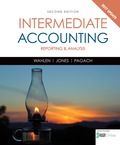
Fill in the blanks labeled from (a) through (l).
Answer to Problem 8E
The balance sheet of D Company is prepared below:
| D Company | ||
| Balance Sheet | ||
| December 31 | ||
| 2016 | 2017 | |
| Current assets | 26,900 | 25,000 |
| Long-term investments | 19,200 | 22,200 |
| Property, plant and equipment (net) | 85,700 | 92,800 |
| Intangible assets | 10,400 | 9,200 |
| Total assets | $142,200 | $149,200 |
| Current liabilities | 14,500 | 12,300 |
| Long-term liabilities | 35,800 | 34,900 |
| Total liabilities | 50,300 | 47,200 |
| Common stock, $5 par | 20,000 | 20,000 |
| Additional paid-in capital | 15,000 | 15,000 |
| Total contributed capital | 35,000 | 35,000 |
| 50,000 | 60,000 | |
| Accumulated other comprehensive income | 6,900 | 7,000 |
| Total shareholders' equity | 91,900 | 102,000 |
| Total liabilities and shareholders' equity | $142,200 | $149,200 |
Table (1)
Explanation of Solution
Balance sheet: This financial statement reports a company’s resources (assets) and claims of creditors (liabilities) and stockholders (
Calculate the amount of current assets (a) for 2016:
Hence, the amount of current assets for 2016 is $26,900.
Calculate the amount of common stock (e) for 2016:
Hence, the amount of common stock for 2016 is $20,000.
Note: As the company did not issue any common stock during 2017, the common stock of 2016 is equal to common stock of 2017.
Calculate the amount of total contributed capital (c) for 2016:
Hence, the amount of total contributed capital for 2016 is $35,000.
Calculate the amount of total stockholders’ equity (f) for 2016:
Hence, the amount of total stockholders’ equity for 2016 is $91,900.
Compute the amount of total liabilities (d) for 2016:
Hence, the amount of total liabilities for 2016 is $50,300.
Calculate the amount of long-term liabilities (b) for 2016:
Hence, the amount of long-term liabilities for 2016 is $35,800.
Calculate the amount of additional paid-in capital (k) for 2017:
Hence, the amount of additional paid in capital for 2017 is $15,000.
Note: As the company did not issue any common stock during 2017, the additional paid in capital of 2016 is equal to additional paid in capital of 2017.
Calculate the amount of total contributed capital (g) for 2017:
Hence, the amount of total contributed capital for 2017 is $35,000.
Calculate the amount of total stockholders’ equity (l) for 2017:
Hence, the amount of total stockholders’ equity for 2017 is $102,000.
Compute the amount of total liabilities (i) for 2017:
Hence, the amount of total liabilities for 2017 is $47,200.
Compute the amount of total assets (j) for 2017:
Hence, the amount of total assets for 2017 is $149,200.
Calculate the amount of long-term investments (h) for 2017:
Hence, the amount of long-term investments for 2017 is $22,200.
Want to see more full solutions like this?
Chapter 4 Solutions
EBK INTERMEDIATE ACCOUNTING: REPORTING
- JH, Inc., is a calendar year, accrual basis corporation with Joe as its sole shareholder (basis in his stock is $90,000). On January 1 of the current year, JH Corporation has accumulated E & P of $200,000. Before considering the effect of the distribution described below, the corporation’s current E & P is $50,000. On November 1, JH distributes an office building to Joe. The office building has an adjusted basis of $80,000 (fair market value of $100,000) and is subject to a mortgage of $110,000. Assume that the building has been depreciated using the ADS method for both income tax and E & P purposes. What are the tax consequences of the distribution to JH and to Joe? (In your answer, be sure to describe the effects on taxable income for both JH and Joe, the impact of the distribution on JH’s E & P, and Joe’s basis in the building.)arrow_forwardJoe is the sole shareholder of JH Corporation. Joe sold his stock to Ethan on October 31 for $150,000. Joe’s basis in JH stock was $50,000 at the start of the year. JH distributed land to Joe immediately before the sale. JH’s basis in the land was $20,000 (fair market value of $25,000). On December 31, Ethan received a $75,000 cash distribution from JH. During the year, JH has $20,000 of current E & P and its accumulated E & P balance on January 1 is $10,000. Which of the following statements is true? a. Joe recognizes a $110,000 gain on the sale of his stock. b. Joe recognizes a $100,000 gain on the sale of his stock. c. Ethan receives $5,000 of dividend income.d. Joe receives $20,000 of dividend income. e. None of the above.arrow_forwardPlease provide the accurate answer to this general accounting problem using appropriate methods.arrow_forward
- Please provide the accurate answer to this general accounting problem using appropriate methods.arrow_forwardI need help with this general accounting question using standard accounting techniques.arrow_forwardCan you help me solve this general accounting question using valid accounting techniques?arrow_forward
- Can you solve this general accounting question with accurate accounting calculations?arrow_forwardI am looking for the correct answer to this general accounting problem using valid accounting standards.arrow_forwardI am looking for help with this general accounting question using proper accounting standards.arrow_forward
- Principles of Accounting Volume 1AccountingISBN:9781947172685Author:OpenStaxPublisher:OpenStax College
 Cornerstones of Financial AccountingAccountingISBN:9781337690881Author:Jay Rich, Jeff JonesPublisher:Cengage Learning
Cornerstones of Financial AccountingAccountingISBN:9781337690881Author:Jay Rich, Jeff JonesPublisher:Cengage Learning Excel Applications for Accounting PrinciplesAccountingISBN:9781111581565Author:Gaylord N. SmithPublisher:Cengage Learning
Excel Applications for Accounting PrinciplesAccountingISBN:9781111581565Author:Gaylord N. SmithPublisher:Cengage Learning


